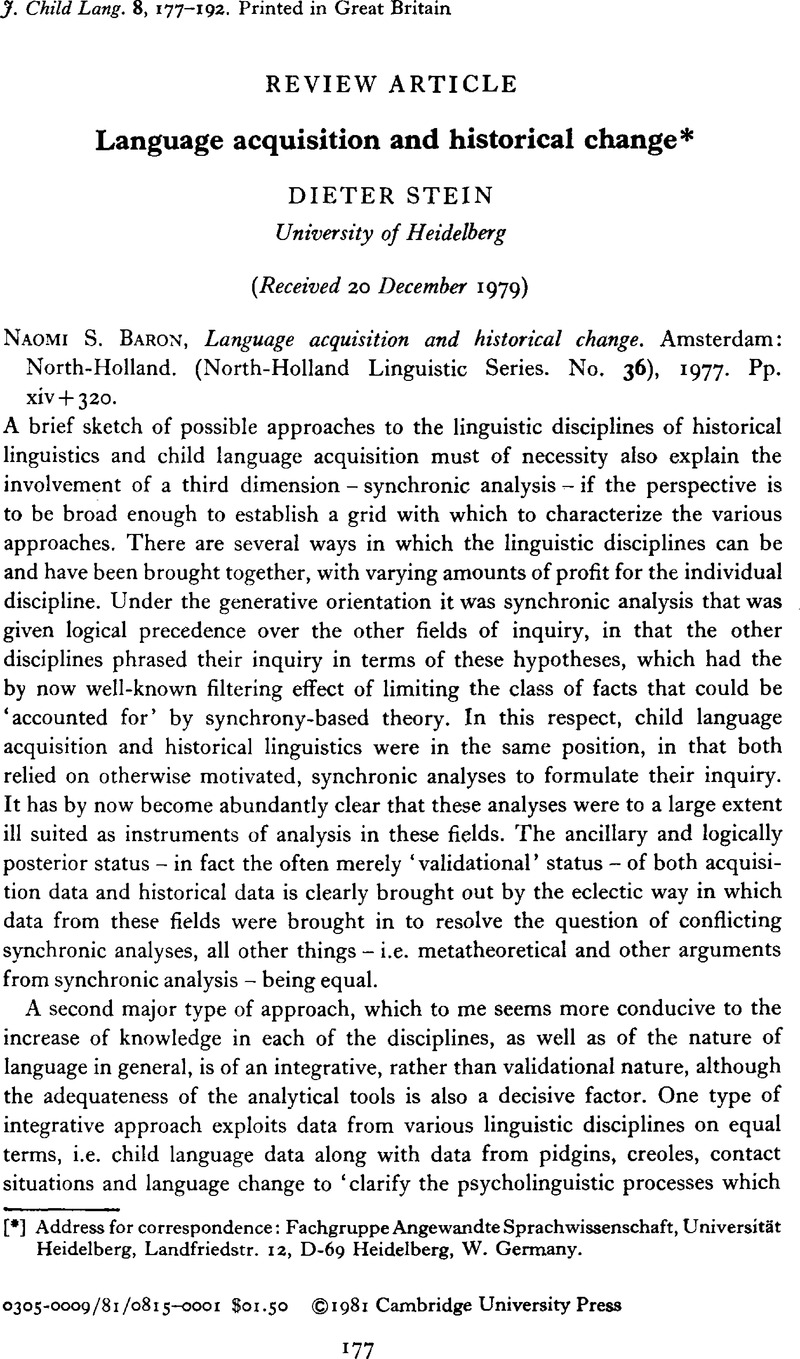No CrossRef data available.
Article contents
Language acquisition and historical change*
Published online by Cambridge University Press: 26 September 2008
Abstract
An abstract is not available for this content so a preview has been provided. Please use the Get access link above for information on how to access this content.

- Type
- Review article
- Information
- Copyright
- Copyright © Cambridge University Press 1981
Footnotes
[*]
Address for correspondence: Fachgruppe Angewandte Sprachwissenschaft, Universität Heidelberg, Landfriedstr. 12, D-69 Heidelberg, W. Germany.
References
REFERENCES
Bailey, C.-J. (1973). Variation and linguistic theory. Arlington: Center for Applied Linguistics.Google Scholar
Bowerman, M. (1974). Learning the structure of causative verbs: a study in the relationship of cognitive, semantic, and syntactic development. PRCLD 8. 142–78.Google Scholar
Bowerman, M. (1976). Semantic factors in the acquisition of rules for word use and sentence construction. In Morehead, D. M. & Morehead, A. E. (eds), Normal and deficient child language. Baltimore: University Park Press.Google Scholar
Ferguson, C. A. & Farwell, C. B. (1975). Words and sounds in early language acquisition. Lg 51. 419–39.Google Scholar
Labov, W. (1972 a). The internal evolution of linguistic rules. In Stockwell, R. P. & Macaulay, R. K. S. (eds), Linguistic change and generative theory. Bloomington: Indiana University Press.Google Scholar
Labov, W. (1972 b). Sociolinguistic patterns. Philadelphia: University of Pennsylvania Press.Google Scholar
MacNamara, J. (1972). Cognitive basis of language learning in infants. PsychRev 79. 1–13.Google Scholar
McCawley, J. (1977). Acquisition models as models of acquisition. In Fasold, R. W. & Shuy, R. W. (eds), Studies in language variation. Washington: Georgetown University Press.Google Scholar
Müller, F. (1977). Erstspracherwerb: theoretische Ansatze, Methoden, Untersuchungen. Studium Linguistik 4. 1–24.Google Scholar
Slobin, D. I. (1973). Cognitive prerequisites for the development of grammar. In Ferguson, C. A. & Slobin, D. I. (eds), Studies of child language development. New York: Holt, Rinehart & Winston.Google Scholar
Slobin, D. I. (1977). Language change in childhood and in history. In MacNamara, J. (ed.), Language learning and thought. New York: Academic Press.Google Scholar
Stein, D. (1977). Intrakorpuskulare Diachronie. Ein Problem für die Theorie des Sprach-wandels. In Viethen, H. W., Bald, W.-D. & Sprengel, K. (eds), Grammatik und inter-disziplinäre Bereiche der Linguistik, Vol. 1. Tübingen: Niemeyer.Google Scholar
Stein, D. (in preparation). Natürlicher syntaktischer Sprachwandel.Google Scholar
Stein, D. (in press). Abduktion in Syntax. To appear in Salzburger Beiträge zur Linguistik 5.Google Scholar
Weinreich, U., Labov, W. & Herzog, M. J. (1968). Empirical foundations for a theory of language change. In Lehmann, W. P. & Malkiel, Y. (eds), Directions for historical linguistics. Austin: University of Texas Press.Google Scholar


